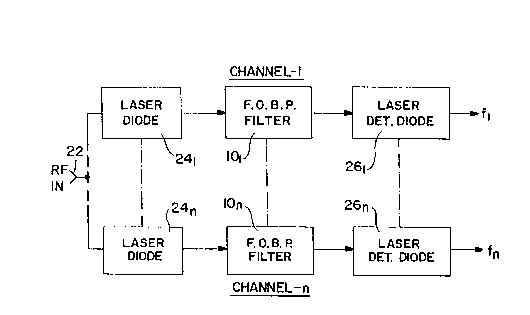Some of the information on this Web page has been provided by external sources. The Government of Canada is not responsible for the accuracy, reliability or currency of the information supplied by external sources. Users wishing to rely upon this information should consult directly with the source of the information. Content provided by external sources is not subject to official languages, privacy and accessibility requirements.
Any discrepancies in the text and image of the Claims and Abstract are due to differing posting times. Text of the Claims and Abstract are posted:
| (12) Patent: | (11) CA 2059587 |
|---|---|
| (54) English Title: | FIBER OPTIC RF SIGNAL CHANNELIZER |
| (54) French Title: | CANALISEUR A FIBRES OPTIQUES POUR SIGNAUX RF |
| Status: | Expired and beyond the Period of Reversal |
| (51) International Patent Classification (IPC): |
|
|---|---|
| (72) Inventors : |
|
| (73) Owners : |
|
| (71) Applicants : |
|
| (74) Agent: | KALEVI P. ASPILAASPILA, KALEVI P. |
| (74) Associate agent: | |
| (45) Issued: | 1999-09-07 |
| (22) Filed Date: | 1992-01-17 |
| (41) Open to Public Inspection: | 1992-08-20 |
| Examination requested: | 1994-02-02 |
| Availability of licence: | N/A |
| Dedicated to the Public: | N/A |
| (25) Language of filing: | English |
| Patent Cooperation Treaty (PCT): | No |
|---|
| (30) Application Priority Data: | ||||||
|---|---|---|---|---|---|---|
|
An array of fiber optic RF filters each responsive to a
predetermined wavelength forms a channelizer for a wide bandwidth
receiver used in a dense signal environment having complex
modulations. Each fiber optic RF filter comprises a resonant
cavity formed from a section of multimode optic fiber with a
dielectric mirror deposited at each end and wherein the cavity
length corresponds to one half the respective modulation signal
wavelength of optical energy fed into the filter optic cavity from
a laser diode which is modulated by the received RF energy.
Note: Claims are shown in the official language in which they were submitted.
Note: Descriptions are shown in the official language in which they were submitted.

2024-08-01:As part of the Next Generation Patents (NGP) transition, the Canadian Patents Database (CPD) now contains a more detailed Event History, which replicates the Event Log of our new back-office solution.
Please note that "Inactive:" events refers to events no longer in use in our new back-office solution.
For a clearer understanding of the status of the application/patent presented on this page, the site Disclaimer , as well as the definitions for Patent , Event History , Maintenance Fee and Payment History should be consulted.
| Description | Date |
|---|---|
| Inactive: IPC expired | 2013-01-01 |
| Inactive: IPC from MCD | 2006-03-11 |
| Inactive: IPC from MCD | 2006-03-11 |
| Time Limit for Reversal Expired | 2001-01-17 |
| Letter Sent | 2000-01-17 |
| Grant by Issuance | 1999-09-07 |
| Inactive: Cover page published | 1999-09-06 |
| Pre-grant | 1999-05-31 |
| Inactive: Final fee received | 1999-05-31 |
| Letter Sent | 1999-05-14 |
| Notice of Allowance is Issued | 1999-05-14 |
| Notice of Allowance is Issued | 1999-05-14 |
| Inactive: Application prosecuted on TS as of Log entry date | 1999-05-10 |
| Inactive: Status info is complete as of Log entry date | 1999-05-10 |
| Inactive: IPC assigned | 1999-04-15 |
| Inactive: Approved for allowance (AFA) | 1999-04-13 |
| Request for Examination Requirements Determined Compliant | 1994-02-02 |
| All Requirements for Examination Determined Compliant | 1994-02-02 |
| Application Published (Open to Public Inspection) | 1992-08-20 |
There is no abandonment history.
The last payment was received on 1998-11-28
Note : If the full payment has not been received on or before the date indicated, a further fee may be required which may be one of the following
Please refer to the CIPO Patent Fees web page to see all current fee amounts.
| Fee Type | Anniversary Year | Due Date | Paid Date |
|---|---|---|---|
| MF (application, 6th anniv.) - standard | 06 | 1998-01-20 | 1997-10-21 |
| MF (application, 7th anniv.) - standard | 07 | 1999-01-18 | 1998-11-28 |
| Final fee - standard | 1999-05-31 |
Note: Records showing the ownership history in alphabetical order.
| Current Owners on Record |
|---|
| GOVERNMENT OF THE UNITED STATES, AS REPRESENTED BY THE SECRETARY OF THE ARMY (THE) |
| Past Owners on Record |
|---|
| CHARLES E. KONIG |